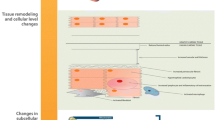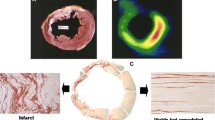Abstract
To date, cardiac resynchronization therapy remains the only treatment that enhances systolic function while improving long-term outcome and survival. Here, we review the molecular alterations associated with dyssynchronous heart failure and their reversibility induced by cardiac resynchronization therapy. We focus upon the molecular portrait of dyssynchronous heart failure and how cardiac resynchronization therapy influences electrophysiologic, metabolic and adrenergic pathways.



Similar content being viewed by others
References
Vardas PE, Auricchio A, Blanc JJ, Daubert JC, Drexler H, Ector H, Gasparini M, Linde C, Morgado FB, Oto A, Sutton R, Trusz-Gluza M, European Society of Cardiology, European Heart Rhythm Association (2007) Guidelines for cardiac pacing and cardiac resynchronization therapy. The Task Force for Cardiac Pacing and Cardiac Resynchronization Therapy of the European Society of Cardiology. Developed in collaboration with the European Heart Rhythm Association. Europace 9(10):959–998
Nelson GS, Berger RD, Fetics BJ, Talbot M, Hare JM, Spinelli JC, Kass DA (2000) Left ventricular or biventricular pacing improves cardiac function at diminished energy cost in patients with dilated cardiomyopathy and left bundle-branch block. Circulation 102:3053–3059
Cleland JG, Daubert JC, Erdmann E, Freemantle N, Gras D, Kappenberger L, Tavazzi L (2005) Cardiac Resynchronization-Heart Failure (CARE-HF) Study Investigators. The effect of cardiac resynchronization on morbidity and mortality in heart failure. N Engl J Med 352:1539–1549
Abraham WT, Fisher WG, Smith AL, Delurgio DB, Leon AR, Loh E, Kocovic DZ, Packer M, Clavell AL, Hayes DL, Ellestad M, Trupp RJ, Underwood J, Pickering F, Truex C, McAtee P, Messenger J (2002) Cardiac resynchronization in chronic heart failure. N Engl J Med 346:1845–1853
Linde C, Leclercq Ch, Rex S, Garrigue S, Lavergne T, Cazeau S, McKenna W, Fitzgerald M, Deharo JC, Alonso C, Walker S, Braunschweig F, Bailleul C, Daubert JC (2002) Long-term benefits of biventricular pacing in congestive heart failure: results from the MUltisite STImulation in Cardiomyopathy (MUSTIC) study. J Am Coll Cardiol 3(40):111–118
Spragg DD, Kass DA (2006) Pathobiology of left ventricular dyssynchrony and resynchronization. Prog Cardiovasc Dis 49(1):26–41
Auricchio A, Stellbrink C, Block M, Sack S, Vogt J, Bakker P, Klein H, Kramer A, Ding J, Salo R, Tockman B, Pochet T, Spinelli J (1999) ffect of pacing chamber and atrioventricular delay on acute systolic function of paced patients with congestive heart failure. The Pacing Therapies for Congestive Heart Failure Study Group. The Guidant Congestive Heart Failure Research Group. Circulation 99(23):2993–3001
Vanderheyden M, Bartunek J (2009) Cardiac resynchronization therapy in dyssynchronous heart failure: zooming in on cellular and molecular mechanisms. Circulation 119(9):1192–1194
Van Oosterhout MF, Prinzen FW, Arts T, Schreuder JJ, Vanagt WY, Cleutjens JP, Reneman RS (1998) Asynchronous electrical activation induces asymmetrical hypertrophy of the left ventricular wall. Circulation 98(6):588–595
Vernooy K, Verbeek XA, Peschar M, Crijns HJ, Arts T, Cornelussen RN, Prinzen FW (2005) Left bundle branch block induces ventricular remodelling and functional septal hypoperfusion. Eur Heart J 26(1):91–98
Prinzen FW, Vernooy K, DeBoeck BWL, Delhaas T (in press) Mechanoenergetics of the asynchronous and resynchronized heart. Heart Fail Rev
Vernooy K, Cornelussen RN, Verbeek XA, Vanagt WY, van Hunnik A, Kuiper M, Arts T, Crijns HJ, Prinzen FW (2007) Cardiac resynchronization therapy cures dyssynchronopathy in canine left bundle-branch block hearts. Eur Heart J 28(17):2148–2155
Leclercq C, Kass DA (2002) Retiming the failing heart: principles and current clinical status of cardiac resynchronization. J Am Coll Cardiol 39(2):194–201
Gao Z, Barth AS, DiSilvestre D, Akar FG, Tian Y, Tanskanen A, Kass DA, Winslow RL, Tomaselli GF (2008) Key pathways associated with heart failure development revealed by gene networks correlated with cardiac remodeling. Physiol Genomics 35(3):222–230
Spragg DD, Leclercq C, Loghmani M, Faris OP, Tunin RS, DiSilvestre D, McVeigh ER, Tomaselli GF, Kass DA (2003) Regional alterations in protein expression in the dyssynchronous failing heart. Circulation 108:929–932
Baller D, Wolpers HG, Zipfel J, Bretschneider HJ, Hellige G (1988) Comparison of the effects of right atrial, right ventricular apex and atrioventricular sequential pacing on myocardial oxygen consumption and cardiac efficiency: a laboratory investigation. Pacing Clin Electrophysiol 11(4):394–403
Boerth RC, Covell JW (1971) Mechanical performance and efficiency of the left ventricle during ventricular stimulation. Am J Physiol 221(6):1686–1691
Bahler RC, Martin P (1985) Effects of loading conditions and inotropic state on rapid filling phase of left ventricle. Am J Physiol 48(42):523–533
Owen CH, Esposito DJ, Davis JW, Glower DD (1998) The effects of ventricular pacing on left ventricular geometry, function, myocardial oxygen consumption, and efficiency of contraction in conscious dogs. Pacing Clin Electrophysiol 21(7):1417–1429
Leclercq C, Gras D, Le Helloco A, Nicol L, Mabo P, Daubert C (1995) Hemodynamic importance of preserving the normal sequence of ventricular activation in permanent cardiac pacing. Am Heart J 129(6):1133–1141
Auricchio A, Prinzen FW (2008) Update on the pathophysiological basics of cardiac resynchronization therapy. Europace 10(7):797–800
Mills RW, Cornelussen RN, Mulligan LJ, Strik M, Rademakers LM, Skadsberg ND, van Hunnik A, Kuiper M, Lampert A, Delhaas T, Prinzen FW (2009) Left ventricular septal and left ventricular apical pacing chronically maintain cardiac contractile coordination, pump function and efficiency. Circ Arrhythm Electrophysiol 2(5):571–579
Leclercq C, Faris O, Tunin R, Johnson J, Kato R, Evans F, Spinelli J, Halperin H, McVeigh E, Kass DA (2002) Systolic improvement and mechanical resynchronization does not require electrical synchrony in the dilated failing heart with left bundle-branch block. Circulation 106(14):1760–1763
Prinzen FW, Peschar M (2002) Relation between the pacing induced sequence of activation and left ventricular pump function in animals. Pacing Clin Electrophysiol 25(41):484–498
Kass DA (2009) Pathobiology of cardiac dyssynchrony and resynchronization. Heart Rhythm 6(11):1660–1665
Sengupta PP, Tondato F, Khandheria BK, Belohlavek M, Jahangir A (2008) Electromechanical activation sequence in normal heart. Heart Fail Clin 4(3):303–314
Aiba T, Hesketh GG, Barth AS, Liu T, Daya S, Chakir K, Dimaano VL, Abraham TP, O’Rourke B, Akar FG, Kass DA, Tomaselli GF (2009) Electrophysiological consequences of dyssynchronous heart failure and its restoration by resynchronization therapy. Circulation 119(9):1220–1230
Zabel M, Koller BS, Sachs F, Franz MR (1996) Stretch-induced voltage changes in the isolated beating heart: importance of the timing of stretch and implications for stretch-activated ion channels. Cardiovasc Res 32(1):120–130
Spragg DD, Akar FG, Helm RH, Tunin RS, Tomaselli GF, Kass DA (2005) Abnormal conduction and repolarization in late-activated myocardium of dyssynchronously contracting hearts. Cardiovasc Res 67(1):77–86
Chakir K, Daya SK, Tunin RS, Helm RH, Byrne MJ, Dimaano VL, Lardo AC, Abraham TP, Tomaselli GF, Kass DA (2008) Reversal of global apoptosis and regional stress kinase activation by cardiac resynchronization. Circulation 117(11):1369–1377
D’Ascia C, Cittadini A, Monti MG, Riccio G (2006) Saccà effects of biventricular pacing on interstitial remodelling, tumor necrosis factor-alpha expression, and apoptotic death in failing human myocardium. Eur Heart J 27(2):201–206
Bilchick KC, Saha SK, Mikolajczyk E, Cope L, Ferguson WJ, Yu W, Girouard S, Kass DA (2006) Differential regional gene expression from cardiac dyssynchrony induced by chronic right ventricular free wall pacing in the mouse. Physiol Genomics 26(2):109–115
Barth AS, Aiba T, Halperin V, DiSilvestre D, Khalid C, Dimaano VL, Yu W, Abraham T, Kass D, Tomaselli GF (2008) Cardiac resynchronization therapy corrects dyssynchrony-induced regional gene expression changes on a genomic level. Circulation 118:S_531
Mullens W, Bartunek J, Wilson Tang WH, Delrue L, Herbots L, Willems R, De Bruyne B, Goethals M, Verstreken S, Vanderheyden M (2008) Early and late effects of cardiac resynchronization therapy on force-frequency relation and contractility regulating gene expression in heart failure patients. Heart Rhythm 5(1):52–59
Vanderheyden M, Mullens W, Delrue L, Goethals M, Verstreken S, Wijns W, De Bruyne B, Bartunek J (2008) Endomyocardial upregulation of betal adrenoreceptor gene expression and myocardial contractile reserve following cardiac resynchronization therapy. J Card Fail 14:172–178
Chakir K, Daya SK, Aiba T, Tunin RS, Dimaano VL, Abraham TP, Lai EW, Pacak K, Zhu W, Xiao R, Tomaselli GF, Kass DA (2009) Mechanisms of enhanced beta-adrenergic reserve from cardiac resynchronization therapy. Circulation 119:1231–1240
De Sousa E, Veksler V, Minajeva A, Kaasik A, Mateo P, Mayoux E, Hoerter J, Bigard X, Serrurier B, Ventura-Clapier R (1999) Subcellular creatine kinase alterations. Implications in heart failure. Circ Res 85(1):68–76
Knaapen P, van Campen LM, Götte MJ, Visser CA, Lammertsma AA, Visser FC (2004) Effects of cardiac resynchronization therapy on myocardial perfusion reserve. Circulation 110(6):646–651
Agnetti G, Kaludercic N, Kane LA, Elliott ST, Guo Y, Chakir K, Samantapudi D, Paolocci N, Tomaselli GF, Kass DA, Van Eyk JE (2010) Modulation of mitochondrial proteome and improved mitochondrial function by biventricular pacing of dyssynchronous failing hearts. Circ Cardiovasc Genet 3(1):78–87
Chung ES, Leon AR, Tavazzi L, Sun JP, Nihoyannopoulos P, Merlino J, Abraham WT, Ghio S, Leclercq C, Bax JJ, Yu CM, Gorcsan J 3rd, St John Sutton M, De Sutter J, Murillo J (2008) Results of the predictors of response to CRT (PROSPECT) trial. Circulation 117(20):2608–2616
Abraham T, Kass D, Tonti G, Tomassoni GF, Abraham WT, Bax JJ, Marwick TH (2009) Imaging cardiac resynchronization therapy. JACC Cardiovasc Imaging 2(4):486–497
Iyengar S, Haas G, Lamba S, Orsinelli DA, Babu GJ, Ferketich AK, Yamokoski L, Periasamy M, Abraham WT (2007) Effect of cardiac resynchronization therapy on myocardial gene expression in patients with nonischemic dilated cardiomyopathy. J Card Fail 13(4):304–311
Vanderheyden M, Mullens W, Delrue L, Goethals M, De Bruyne B, Wijns W, Geelen P, Verstreken S, Wellens F, Bartunek J (2008) Myocardial gene expression in heart failure patients treated with cardiac resynchronization therapy responders versus nonresponders. J Am Coll Cardiol 51(2):129–136
Author information
Authors and Affiliations
Corresponding author
Additional information
This work has been supported by the Meijer-Lavino Foundation for Cardiac Research, Aalst, Belgium and by the 3M Pharma Prize (MV, JB).
Rights and permissions
About this article
Cite this article
Vanderheyden, M., Vrints, C. & Bartunek, J. The molecular fingerprint of cardiac dyssynchrony and cardiac resynchronization therapy. Heart Fail Rev 16, 227–233 (2011). https://doi.org/10.1007/s10741-010-9199-x
Published:
Issue Date:
DOI: https://doi.org/10.1007/s10741-010-9199-x




